
The 8th edition of Nartaka Festival
Text & pics: Lalitha Venkat
e-mail: lalvenkat@yahoo.com
November 4, 2014
Dedicated to the male dancer, the eighth edition of the Nartaka Festival
organized by Natyanjali Trust on Oct 30, Nov 1 and 2, 2014, took place
at the newly renovated Bharatiya Vidya Bhavan in Mylapore, Chennai.
There are now less number of seats and more space to move around. The
stage décor was simple, with the organization banner on top, without
marring the plain backdrop.
After the prayer song by Shankari Subramaniam, the festival commenced
with a duet recital by Christopher Gurusamy and B. Harikrishnan to
‘Roopamu joochi” in Todi ragam composed by Muthuswamy Dikshitar and
choreographed by Rukmini Devi. The dancers were quite well
coordinated. Christopher next presented a Sarangapani padam “Chittike
vesite…” in Kalyani ragam (adi) choreographed by Bragha Bessell. When
Krishna is scorned by a girl, he says he is Muvva Gopala and all he has
to do is snap his fingers and a thousand young damsels will rush to his
side. Christopher has a naturally pleasant face and his looks of scorn
remained mild. B. Harikrishnan next presented “Yaaro ivar yaaro” in
Bhairavi from Ramanatakam by Arunachala Kavirayar. In this Rama sees
Sita as Vishnu would see Lakshmi in this avatar, how something seems
familiar about her, as if he knows her from somewhere. The dancer could
have been more expressive. The duo finished with a Thillana in Paras, a
composition of Poochi Srinivasa Iyengar. Though the dancers were quite
in sync in the nritta segments, on the whole the spark was missing. The
music ensemble included G Srikanth on vocal, Sruti Sagar on flute, M
Girish on nattuvangam and Guru Bharadwaj on mridangam.
The next performance was by Ajith Bhaskaran Dass (Director, Suvarna Fine
Arts) and his three disciples Vijay Chandran, Vijayan Veeryan and
Parthiben Sethu from Malaysia. The group started with a neatly presented
Suvarna Surya in Ragamalika composed by vocalist Hariprasad as a
salutation to the sun god woven around an alarippu, revering Surya as
Aditya, the inspirer, Suvarna, the golden hued one and Bhaskara, the
resplendent one. This item was specially choreographed for the Nartaka
Festival. Ajith was totally involved in his solo depiction of
“Mohamana…” in ragam Bhairavi, a composition of the Thanjavur Quartet
about the lovelorn nayika who yearns for her lord’s divine presence, her
agony worsened by Manmatha’s arrows of love. The rhythmic compositions
were set by mridangist Ramamurthy Ganesh. This was choreographed by
Ajith himself based on his own interpretation. The final item “Engum
Chidambaram ellam Siva mayam” was a lively number by the group in which
each element of the pancha bhutas were visualized in Shiva’s dance.
Ajith said that the Nartaka Festival had given him an opportunity to
share his experimental work in the Bharatanatyam idiom. The other
members of the orchestra who gave good support were L Subhasri on
nattuvangam, Sruti Sagar on flute and Lakshmi Venkatramani on violin.
Having always seen Sai Santosh Radhakrishnan in group productions, it
was a pleasure to see this talented disciple of Guru Adyar Lakshman
present a polished solo recital. Despite his height, Sai Santosh is
light on his feet. Clad in a pleasant costume in yellow and turquoise
blue, he started with a mallari and then on to the main piece, the
varnam “Enthaniney thelupudura” in Khamas (rupaka talam) by Subbarama
Dikshitar choreographed by his guru. The nayika pleads with
Thyagarajaswami that she has asked him umpteen times to be kind to her.
She implores him to ignore what others say and respond to her love
instead. Sai Santosh was at his most expressive, with gracefully precise
movements in the moderately paced jathis that lent a soothing quality
to the recital. Even the way he removed his errant silver poonal and
dropped it on a stool by the wings during the varnam was graceful!
Vocalist G Srikanth was clearly now in his element and sang soulfully.
Easwar Ramakrishnan on violin, Sruti Sagar on flute, Nellai Kannan on
mridangam and Aadith Narayan on nattuvangam visibly enjoyed their role
and this joy transmitted itself to the audience. The third item was a
soulful rendition in music and dance of the seventh ashtapadi of
Jayadeva “Maameeyam Chalitha” in Hamir Kalyani choreographed by Bragha
Bessell in which Krishna pines for Radha that there is no use of all the
wealth and possessions when his Radha is angry with him. The sprightly
thillana in Hindolam was a composition of Madurai N Krishnan and
choreographed by Adyar Lakshman. The brief flute and violin interludes
between items were much appreciated.
View Slide show
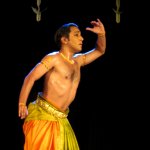
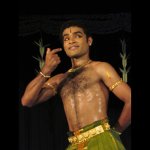
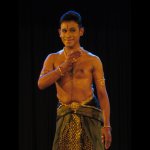
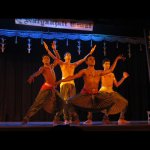
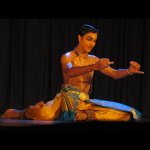
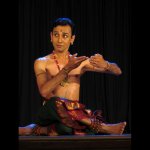
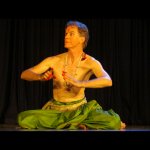
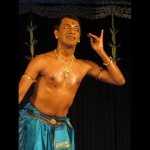
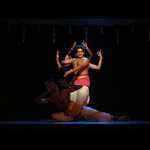
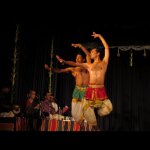
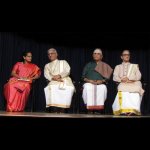
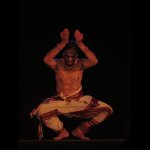
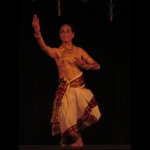
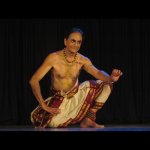
After a day’s break, the second day of the fest started with a recital
by Bangalore based P Praveen Kumar wearing a nice costume in dark green
with maroon border. After the Ganapati Vandana of Tulsidas in raag
Kalavati (adi), composed and choreographed by his Guru CV Chandrasekhar,
Praveen with his customary finesse presented varnam “Swami naan undhan
adimai” of Papanasam Sivan in ragam Nattakurunji (adi) about the love of
devotees for the lord of dance. Whether as the devotee delighting in
chanting the name of Shiva, beseeching the lord for his darshan, or as
Shiva himself freezing into sculpturesque dance poses, Praveen was in
elegant form. The presentation was further enhanced by the clear
pronunciation of the vocalist! In the javali “Taaru maaru” by
Moovalur Pattabhiramaiah in Nattakurunji, Praveen expressively portrayed
the outraged drushta nayaka trying to woo the heroine but is rebuffed
by his lady love who has seen through his errant ways. From the rejected
lover of the javali, it was the turn of the doting father of little
Krishna in the concluding item, a devarnama of Purandaradasa “Mane
yolagado Govinda.” He urges little Krishna not to go out to play since
the neighbours complained about him. He tries to bribe the child by
offering butter and jewellery items to have him play at home. Dancing to
recorded music, Praveen’s abhinaya was contained and he maintained a
good energy level throughout.
The next performer was Justin McCarthy from Delhi. So far, all the
dancers have kept their announcements brief and to the point but the
ultra briefest announcement for Justin was that the artiste would
perform “Alarippu, varnam in Khamas, padam Payyada, javali Vagalaadi and
thillana!” And the orchestra was also not introduced either during or
end of recital. It was unusual to see a male dancer with alta on
the tips of his fingers. The varnam was “Samiyai azhaithu vaa.” He
performed “Payyada” in a seated position and despite his naturally
smiling face, he was quite emotive in this abhinaya intense piece.
Justin’s presentation had the charm of the old tradition of
Bharatanatyam. He was accompanied by Sudha Raghuraman on vocal, Lokesh
Bharadwaj on nattuvangam, Sriganesh on mridangam and Raghuraman on
flute.
The last performer of the evening was Shankar Kandasamy, head of the
dance department at the Temple of Fine Arts, Malaysia. He first
presented a Saraswati kautvam as vandana that he penned himself in a
moment of inspiration, followed by a verse from Sakalakalavalli Maalai
of Kumaragurupara Swamigal. Shankar dedicated the popular Kalyani
jatiswaram performed in Kalakshetra style (that he had learnt from
visiting students) to Guru Subbaraya Pillai. As one who makes his annual
pilgrimage to the Ganga every year and is lured by her transformative
quality, Shankar penned lyrics on Ganga in English and this was
translated by Prof. Shankar Rajaram into Sanskrit and composed by G
Sridhar. The episodes include many stories of Ganga like the story of
Bhagiratha, the origin of Ganga, Shiva catching Ganga in his matted
locks, as the mother of Subramanya, how Vishnu is entranced on hearing
Shiva playing the rudra veena and rides his garuda vahana to Himalayas
to see him play etc. The explanation was rather lengthy and there were
far too many stories involved but the vivid portrayal of these stories
through interesting choreography interspersed with strong jathis
composed by Prasanna earned Shankar many rounds of applause through the
item. Since the piece was very long, the artiste had already overshot
his time limit and should have ended his recital with that, but he went
on to conclude with “Pitham Theliya” of Gopalkrishna Bharati on
Nandanar, after another lengthy explanation. Shankar has a distinct body
language and his passion for dance comes across in his presentation. It
was sensitively performed but by now, he had exceeded by more than 40
minutes and this was truly vexing. It was more like an evening of
solo recital than an evening of shared performances. Nanda Kumar
accompanied on vocal, Chandrasekhar on mridangam and Shashidar on flute.
The last day of the festival saw a full hall. Guru VP Dhananjayan
presented 8 of his senior male disciples who are professionals and also
on the Bharatakalanjali faculty in Nartaka Nartanam. He said, “It’s very
rare to have on stage, an all male ensemble, especially since it is
difficult to get everyone together. There are many wonderful male
Bharatanatyam dancers today and many who have chosen to make dance as a
career.” The first item Nataraja Anjali composed by Bhagavatula
Seetharama Sharma from the Periya Puranam saw all 8 dancers storm the
stage in collective energy. Nritta Swaravali – pure dance sequence set
to musical notes – was composed in ragam Mohanam by TV Gopalakrishnan in
1978 when on a train journey in Europe. It was further embellished by
Dhananjayan and the choreography set then “is still like a fresh piece
since it has innovative postures, movements and structure, almost like
contemporary modern patterns. It has been set as solo, duet as well as
on varied number of dancers.” 4 dancers performed this piece and the
next Swati Thirunal keertanam “Shankara sri giri” in Hamsanandi ragam
replete with Nataraja poses. The finale was Nritta Angaharam in Behag
composed by Thurayur Rajagopala Sharma. It was composed and
choreographed in 1969 and has been a favorite in the Bharatakalanjali
repertoire through the years. With a quick change of costume, 6 dancers
treated us to a scintillating display of nartaka natanam.
Dhananjayan’s ‘ashtanayakas’ were Anand Sachidanand, Shafeekuddin,
Shivadas, Venkatakrishnan, Suresh Sridar, Sarveshan, Uttio Baruah and
Gopu Kiran. The supportive music ensemble had Shanta Dhananjayan on
nattuvangam, Rajesh on vocal, TK Padmanabhan on violin, Ramesh Babu on
mridangam and Sunil Kumar on flute.
It was then time for speeches by Guru CV Chandrasekhar reminiscing about
times at Kalakshetra, how this festival is dedicated to not only
Subbaraya Pillai but the Pandanallur school and all its masters too.
Mridangam maestro Umayalpuram Sivaraman as chief guest conferred this
year’s Nartaka Award (that carries a purse of Rs.25,000) on Guru VP Dhananjayan, who revealed that he had
actually attended a few mridangam classes at Sivaraman’s school many
years back!
The grand finale of the fest was an outstanding recital by Guru CV
Chandrasekar. His costume in off-white with maroon border was striking.
He commenced with a Thyagaraja kriti “Sri Ganapathini sevimparare” in
Saurashtram. The Tamil varnam in Kambodi “Naadanai azhaithu vaa
sakhiye,” a composition of Nataraja Pillai, had everyone glued to their
seats. The nritta portions were performed with gusto with the energy of a
youngster with no compromise on the movements, be it araimandi, full
squat, sliding to the floor or getting up with ease. He went through all
the emotional upheavals of the heroine, his subtle expressions a lesson
in abhinaya for the dancers watching him with awe. The final item was a
poem from Muthukumaraswamy Pillai Thamizh written by Kumaragurupara
about the childhood pranks of little Muruga with his mother and father, a
total change from the lovelorn nayika of the previous item pining for
Kumara. It is no wonder he got a standing ovation. He was accompanied by
Jaya Chandrasekhar on nattuvangam, K Hariprasad on vocal, Sashidhar on
flute, Nagarajan on mridangam and Eswar Ramakrishnan on violin. CV
Chandrasekar is the brain behind the Nartaka Festival as well as the
first recipient of the Nartaka award.
Prema Satish of Natyanjali, herself a disciple of Pandanallur Subbaraya
Pillai, had interacted with him from the time she was 6 till he passed
away in 2008, even training in his home at Pandanallur for a few years.
She celebrated the memory of her guru with the Nartaka Festival, this
year being his birth centenary, and the focus was the Bharatantayam
style. The homage to her guru continues in Natyanjali’s Natya Utsav for
women dancers from Nov 7 to 9 at Bharatiya Vidya Bhavan in Chennai.
Lalitha Venkat is the content editor of www.narthaki.com
|





